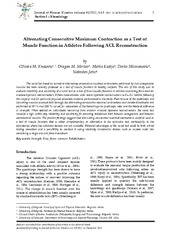Приказ основних података о документу
Alternating Consecutive Maximum Contraction as a Test of Muscle Function in Athletes Following ACL Reconstruction
| dc.creator | Knežević, Olivera | |
| dc.creator | Mirkov, Dragan M. | |
| dc.creator | Kadija, Marko | |
| dc.creator | Milovanović, Darko | |
| dc.creator | Jarić, Slobodan | |
| dc.date.accessioned | 2021-04-20T12:27:25Z | |
| dc.date.available | 2021-04-20T12:27:25Z | |
| dc.date.issued | 2012 | |
| dc.identifier.issn | 1640-5544 | |
| dc.identifier.uri | http://rimi.imi.bg.ac.rs/handle/123456789/388 | |
| dc.description.abstract | The novel test based on isometric alternating consecutive maximal contractions performed by two antagonistic muscles has been recently proposed as a test of muscle function in healthy subjects. The aim of this study was to evaluate reliability and sensitivity of a novel test as a test of knee muscles function in athletes recovering from anterior cruciate ligament reconstruction. Fifteen male athletes with recent ligament reconstruction (4.0 +/- 0.1 months following the surgery) and 15 sport and physical education students participated in the study. Peak torques of the quadriceps and hamstring muscles assessed both through the alternating consecutive maximal contractions and standard isokinetic test performed at 60 ((degrees) under bar)/s and 180 ((degrees) under bar)/s served for calculation of the hamstrings-to-quadriceps ratio and the bilateral difference in strength. When applied on individuals recovering from anterior cruciate ligament reconstruction, the novel test revealed a high within-day reliability and sensitivity for detecting imbalances both between antagonistic and between contralateral muscles. The present findings suggest that alternating consecutive maximal contractions could be used as a test of muscle function that is either complementary or alternative to the isokinetic test, particularly in the laboratories where the isokinetic devices are not available. Potential advantages of the novel test could be both a brief testing procedure and a possibility to conduct it using relatively inexpensive devices such as custom made kits containing a single one-axis force transducer. | en |
| dc.publisher | De Gruyter Poland Sp Zoo, Warsaw | |
| dc.relation | US National Institute of Health (R21AR06065) | |
| dc.relation | info:eu-repo/grantAgreement/MESTD/Basic Research (BR or ON)/175037/RS// | |
| dc.relation | info:eu-repo/grantAgreement/MESTD/Basic Research (BR or ON)/175012/RS// | |
| dc.rights | openAccess | |
| dc.source | Journal of Human Kinetics | |
| dc.subject | Strength | en |
| dc.subject | Knee | en |
| dc.subject | flexor | en |
| dc.subject | extensor | en |
| dc.subject | Rehabilitation | en |
| dc.title | Alternating Consecutive Maximum Contraction as a Test of Muscle Function in Athletes Following ACL Reconstruction | en |
| dc.type | article | |
| dc.rights.license | ARR | |
| dc.citation.epage | 13 | |
| dc.citation.other | 35: 5-13 | |
| dc.citation.rank | M23 | |
| dc.citation.spage | 5 | |
| dc.citation.volume | 35 | |
| dc.identifier.doi | 10.2478/v10078-012-0074-9 | |
| dc.identifier.fulltext | http://rimi.imi.bg.ac.rs/bitstream/id/299/385.pdf | |
| dc.identifier.pmid | 23487010 | |
| dc.identifier.scopus | 2-s2.0-84878316863 | |
| dc.identifier.wos | 000314671100001 | |
| dc.type.version | publishedVersion |

